We joined a Road Scholar bike tour of Northern Holland with our friends, Mark and Mary Ellen Meyer, for the first week of our visit to the Netherlands. The second week we spent with our kids in Amsterdam. Here are a few things we noted:
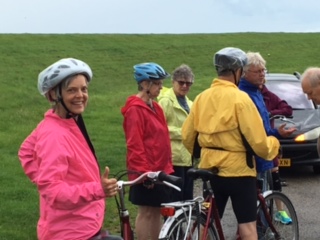
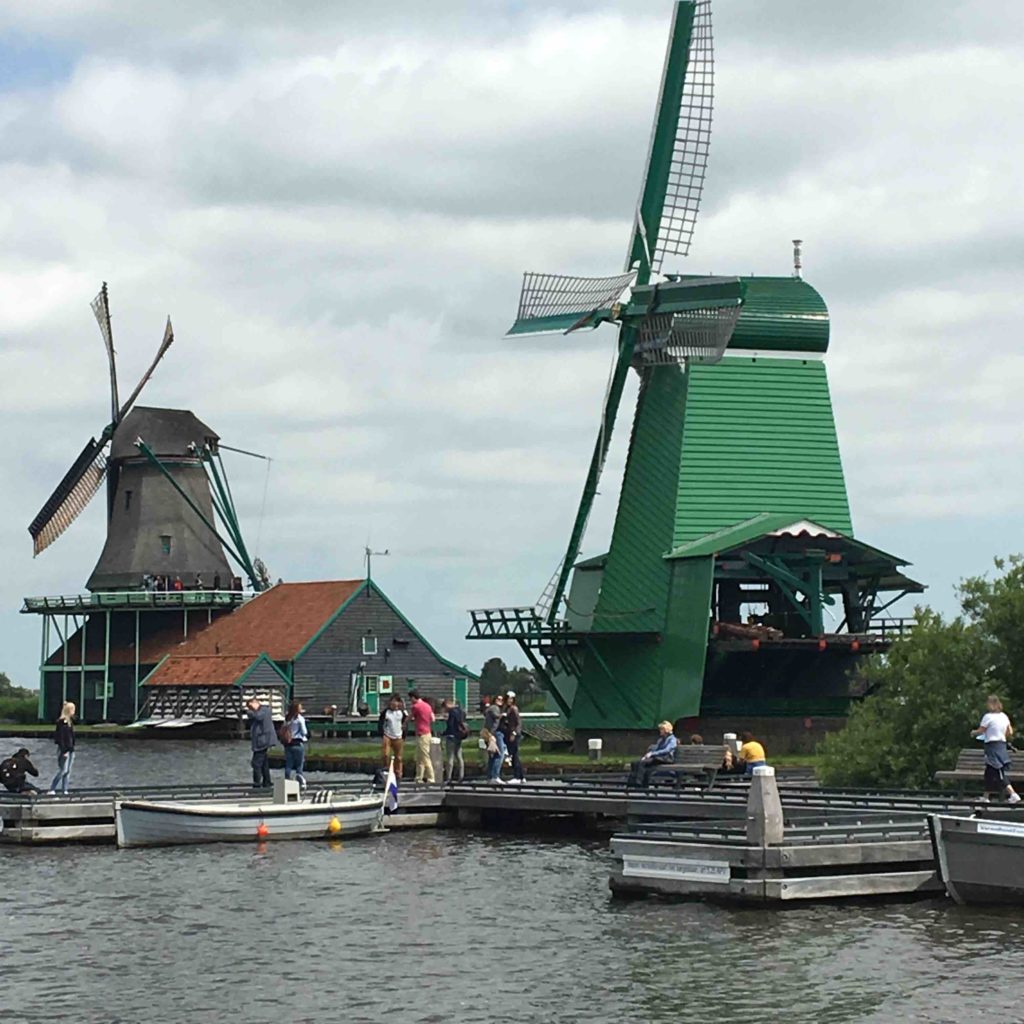
We joined a Road Scholar bike tour of Northern Holland with our friends, Mark and Mary Ellen Meyer, for the first week of our visit to the Netherlands. The second week we spent with our kids in Amsterdam. Here are a few things we noted:


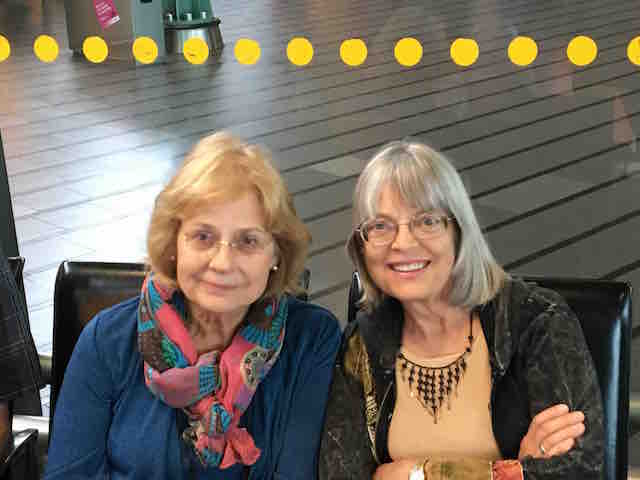

We glided into AMS a few minutes early just as we discovered we had left our trip itinerary and assorted maps at home. Oops, fumble! It didn’t matter though, as we proceeded through passport check and baggage pickup and immediately connected with Mark and Mary Ellen, our old friends and travel companions. They knew how to get to the Road Scholar rendezvous point, which was the only critical information for now.
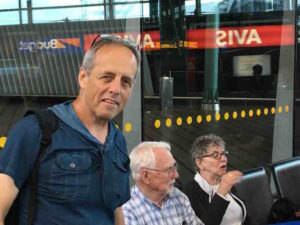 After hugs and some quick catch-up, we found our tour leader, Joppe, and greeted our traveler companions for the week. There are 11 of us plus Joppe, a nice small group. A short while later, we were on a bus, headed for Schoorl near the Holland coast. But first, we stopped at a replica of a Dutch village to see some sights and get lunch.
After hugs and some quick catch-up, we found our tour leader, Joppe, and greeted our traveler companions for the week. There are 11 of us plus Joppe, a nice small group. A short while later, we were on a bus, headed for Schoorl near the Holland coast. But first, we stopped at a replica of a Dutch village to see some sights and get lunch.
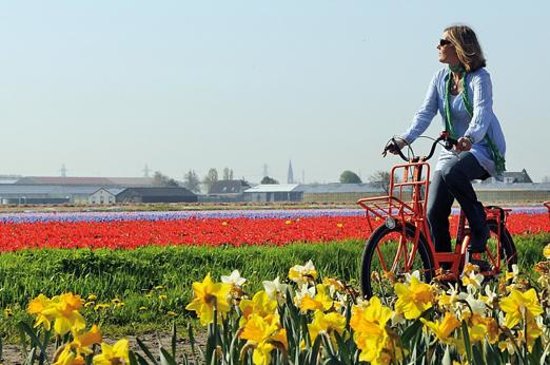

 Here we go, pursuing a cultural/cycling adventure in the land of bikes–the Netherlands. Betsy and I, along with our Pittsburgh friends, Mark and Mary Ellen, plan to pedal our way through a Roads Scholar “Touch of Dutch Life: Leisurely Biking in the Netherlands” program for a week. Then we plan to retreat to Amsterdam and take over a couple apartments for a week with our children and their SO’s.
Here we go, pursuing a cultural/cycling adventure in the land of bikes–the Netherlands. Betsy and I, along with our Pittsburgh friends, Mark and Mary Ellen, plan to pedal our way through a Roads Scholar “Touch of Dutch Life: Leisurely Biking in the Netherlands” program for a week. Then we plan to retreat to Amsterdam and take over a couple apartments for a week with our children and their SO’s.
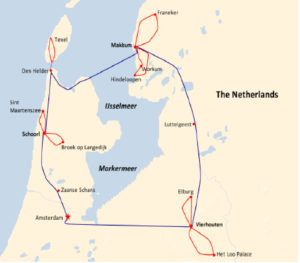
Our cycling route through Holland–the red loops show cycling, the grey loop shows the bus transfers.
We’ve already been warned that American cyclists will be ill-prepared for the road rules in Amsterdam. Our goal is not to take down a Dutch cyclist and create an international incident. Maybe my Dutch heritage (c. 1880) will give me native chops when it comes to two wheels in the city–right, dream on, Hans!
 Our arrival was not promising at the village of de Zaanse Schans given the lineup of tour buses. It spoke of a tourist hotspot, a camera swarm, which is not our kind of thing. The wooden shoe factory confirmed the suspicions. Curious as the concept of wooden shoes is, I’ve had a pair available since I was a child living near Holland, Michigan, and they lost their luster long ago. Have you ever tried walking in wooden shoes? Let’s just say you won’t be tempted to give up your Rockports or Air Jordans. Of
Our arrival was not promising at the village of de Zaanse Schans given the lineup of tour buses. It spoke of a tourist hotspot, a camera swarm, which is not our kind of thing. The wooden shoe factory confirmed the suspicions. Curious as the concept of wooden shoes is, I’ve had a pair available since I was a child living near Holland, Michigan, and they lost their luster long ago. Have you ever tried walking in wooden shoes? Let’s just say you won’t be tempted to give up your Rockports or Air Jordans. Of
course, that didn’t keep us from a couple photo ops.
On the other hand, the old windmills caught my attention. They are more interesting in real life than on a postcard with tulips. It becomes clear up close how they are inspired by 17th century sailing ship technology. Take a look….
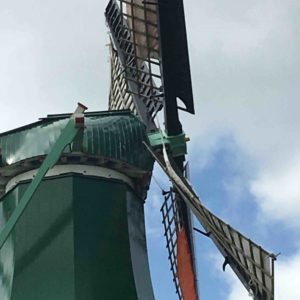
The blades are sail cloth mounted over a lattice frame. Note contoured blade frames to turn in the wind.
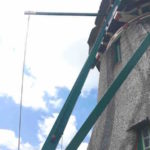
The rope and lever disconnects the windmill head from the gearing. You can also take down the sails to protect the windmill in high wind.
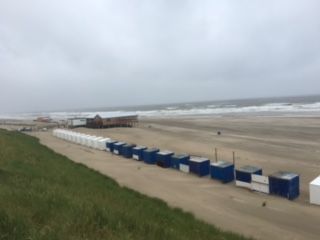

We woke up Monday morning to a light steady rain, 56 degrees, 15-20 mph wind, and an all day forecast for the same. Our itinerary called for a 7 mi. ride to the North Sea–that surliest of seas–and our group leader, Joppe, suggested we sit out the day in our hotel. We weren’t having any of it—everyone had rain coats and chose to ride.
We saddled up and rode a bike trail through sand dunes and national forest to the shore where we planned to have lunch at the beachside cafe. The cold, wind, rain and lonely outpost of a cafe recalled summits of Alpine passes from earlier bike trips. To Joppe’s surprise, the cafe was closed on Mondays and we were preparing to turn around for a teeth-chattering ride back to our hotel when a young man on a scooter caught up to our huddled group at the locked cafe entrance. After a short negotiation with Joppe, he agreed to open the cafe and serve us what he could find. Our hero! After an hour of warmth, hot chocolate and ham sandwiches, we were fortified and ready for the return trip. Joppe found a shortcut back to the hotel, and we arrived a bit bedraggled but energized by our hardiness in the bad weather.
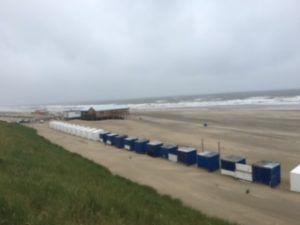
The North Sea coastline. The huts are for swimsuit changing, but it’s hard to imagine a warm sunny day


Tuesday morning our little duckling line of bikes set out for the historic Langedijk (Long Dike) vegetable market about 8 miles away. We wound through Schoorl via bike lanes and trails, then hit a bike trail that led us along a canal through open countryside toward Langedijk.
The area around Langedijk, as well as the town itself, is reclaimed salt marshes called the “Realm of a Thousand Islands”, but in fact over 15,000 islands have been created over the centuries. How do you make an island? You dig a canal in the marsh, mound the dirt on one side, and voila!, you have an island AND a canal. Now you can farm the island. This creates a dense archipelago of tiny islands (a typical island may be 30 m. x 300 m.) for cultivation, each one accessible only by boat and connected via a vast network of canals.
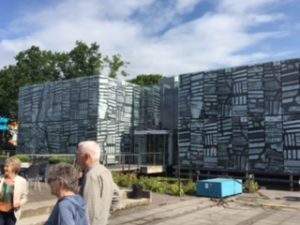
A new visitors center has a map showing the archipelago of islands etched onto the glass of its facade
How do you get your produce to market? By boat, of course, to a wholesale auction house that straddles a canal. The system is ingenious and organized, and it thrived until the 1960’s, at which time roads, trucks, large-scale agriculture, and filled-in canals overtook its function. Today it exists as an experiential museum for visitors and the small islands are farmed by volunteer groups of organic farmers. It remains a fascinating look at Dutch engineering, collective industriousness and social organization.


The Dutch are a frugal people. Americans would call them “tightwads”. The concept of paying more for something than another person is very hard to swallow for a Dutch person so the traditional “bidding up” auction system presented a major cultural hurdle.
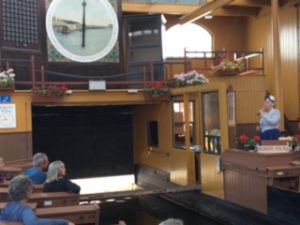
The canal runs down the middle of the auction house, between the auctioneer and the bidders. The gangway plank crosses the canal.
And thus was born the Dutch auction. In a Dutch auction, a product is offered at a high price; then the price is incrementally lowered until a Dutch person, finding it a suitable bargain far below the initial offering price, announces his/her willingness to pay. The result is the same as a conventional auction without the psychic damage of “paying more than Hans”.
This is the format used for decades at the Langedijk Vegetable Auction House. We participated in a re-enacted auction for visitors in which we bought apples (a deal), kiwi fruit (trader of the day award) and 4 bushels of onions (waayyy overpaid). The onions were proof that a Dutch auction doesn’t guarantee the bidder a bargain!
Texel is an island just off the Dutch coast accessible only by a short ferry ride. On Tuesday afternoon we loaded our luggage and bikes and boarded a van-sized bus to drive to Den Helder where we could catch the ferry and visit Ecomare, a marine rescue center and sanctuary on Texel. Ecomare is set into the dunes leading to the North Sea and is essentially an aquarium and nature center. It’s very nice if
somewhat predictable. The afternoon’s main feature turned out to be the ferry, which loaded more bikes and pedestrians than cars.
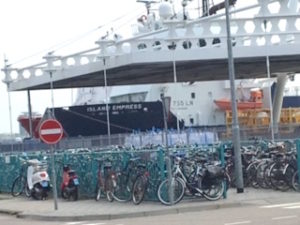
….and lots more bikes are left at the mainland dock by ferry riders. This was the most efficient ferry loading I have ever witnessed–the loading, crossing and unloading took less than 30 minutes.
We returned by ferry later in the afternoon and crossed the Afsluitdijk, Netherland’s longest dike at 20 miles, to get to Makkum, our base for the next 3 days. Built in 1927-1932, the Afsluitdijk cut off the large bay known as the Zuiderzee (South Sea) from the North Sea, turning it into a large freshwater lake now called the IJsselmeer. Those Dutch can dike anything! Later they diked off the southeastern section of the IJsselmeer to turn it into farmland. This, of course, was long before the days of Environmental Impact Statements.
The Dutch are champion milkers. Everywhere we ride our bikes we see sheep, goats, and–especially–cows. We have cream soups, cream sauces, ice cream and whipped cream at every evening meal, and cheese finds its way into most entrees as well. Milk and milk products are the Dutch’s foremost agricultural export–they nurse much of Europe. And they have a problem–the problem of Sunny Boy–that you might not know if you casually pedal by the herds of cows.
Sunny Boy is a Dutch Holstein bull who became a “movie star” in the dairy breeding industry by producing over 1.7 million straws (units) of semen and siring 500,000 daughters. It goes without saying that his daughters were particularly well-formed and prodigious milk producers. This created great demand, and Sunny Boy was able to meet the demand until his death a few years ago.
It also instilled one strong genetic line into a large percentage of Dutch dairy herds, bringing with it the dangers of inbreeding. Most would-be Dutch successors to Sunny Boy are grandsons or great-grandsons, unable to solve the problem. Therefore the search is on–for one or preferably several bulls with fresh bloodlines, the ability to pass on great milk-producing traits, and prolific semen output. Perhaps the progeny of Toystory–an American Holstein and “titan of artificial insemination” who surpassed Sunny Boy in 2012 with 2 million straws produced–will hold the answer. The Dutch diet and agricultural exports depend on it!
For a more nuanced understanding of the issues, click here.
We mounted our bikes in light drizzle once again on Weds. morning and headed into Friesland. Every day we asked Joppe what the weather would be and we got the same response: “Today you should pack a raincoat—just in case. Tomorrow will be beautiful!” And every day we packed raincoats because, as Joppe also declared, “You are in Holland. It can rain any time!”
How did Friesland enter the picture? We crossed the Afsliendijk, which brought us from the province of North Holland to the province of Friesland. A brief geography lesson: The Netherlands has 12 provinces, of which South Holland and North Holland are the best known, the largest, and contain the two largest cities, Amsterdam and Rotterdam. Thus, the Netherlands is frequently referred to as “Holland”, though the two, strictly speaking, are not interchangeable.
Friesland is also a province, but quite a singular one. It clings to a separate identity, which includes its own language, Frisian, and a history that includes Vikings and Germanic nobles. In reality, Frisian culture in the 21st century seems more a state of mind than anything. Frieslanders are indistinguishable in looks and stature from other Dutch; they speak Dutch as well as Frisian; they are Protestants like other northern Dutch; and parliamentary districts cross borders among provinces so Frieslanders don’t have a distinct political voice.
Nonetheless, they maintain a pride of place and culture unique to them. From our perspective, their most observable achievement is the Frisian horses, formerly draft horses, now used for carriage-pulling and riding. They look very spirited and graceful roaming green pastures and frequently have greeted us with great interest as we passed on our bikes.


Twelve miles into Friesland, we came to the town of Franeker, site of the world’s oldest working planetarium. Eise Eisenga left school early, married and developed a wool carding business. As a boy, he was a precocious mathematics student and, self-taught, he continued his interest in math and physics into adulthood.
In response to a unique planetary alignment in 1774 that certain religious types touted as forecasting the apocalypse, Eisenga designed and built a working planetarium in the ceiling of his living room with accurate, continuously-moving relationships between the sun and all known planets. His living room, by the way, happened to be his bedroom, dining room and kitchen as well. It took him until 1781. No wonder he and his first wife only had one child!
He designed and meticulously made the gear works, located in the attic above the living room ceiling, from wood disks and 10,000 steel nails that became the gear teeth. The assemblage looks like the works of an over-scaled Swiss watch. To those of us who still find astronomy and orbits an insolvable brain-teaser, how Eise could have pulled this off at the time of Thomas Jefferson is a confounding mystery!
When the Dutch king heard of Eisenga’s feat and visited remote Franeker to see the planetarium in the early 1800’s, Eisenga’s fame and future were assured, and in 2011, the Dutch government nominated the planetarium to be a UNESCO World Heritage site.
Thursday was another of Joppe’s “beautiful” days so we put on the rain coats and pedaled into Friesland again. After 10 or so miles, we came to our first stop of the day, an organic cheese and dairy farm near Workum. Otto Jan and his brother operate 4 farms consisting of 400 Jersey cows, all raised and fed organically. As with so many businesses we visited in northern Netherlands, it was
family owned and operated, and management and labor were barely distinguishable. Otto gave us a tour and spoke with us for an hour.
We returned to our bikes and the light rain and headed a couple miles south to Hinderloopen. There we found the Ice Skate Museum in an inauspicious old house filled with antiques. Equally important, the owner is a decorative painter who has made a living for 50 years painting unique
Hindeloopen motifs on chairs, pottery, special boxes and just about anything else you can think of. It turns out that, historically, each town had it’s unique decorative floral designs and artists; now he and his son are the only ones left in Hindeloopen, and there are few left in Friesland.
Our little group then repaired to the seashore to sample smoked eel. We found a little over-the-counter fish house, waited our turn, ordered our eel, and struck up a conversation with a man busying himself with sundry things outside. He, it turned out, is also the last of a kind in Hindeloopen. He and his wife own the restaurant and fishing
boat, and he catches eel via 1,500 eel traps and smokes them in a box outside his restaurant. In earlier days, 30 fisherman operated out of Hindeloopen he said. Only he remains.
We pedaled back to our Makkum hotel reflecting on new prospering family businesses and older family trades that are thriving and dying at the same time.


On Friday morning, we loaded our van-bus to transfer to the little village of Vierhouten, set in a large tract of woods owned by the Dutch Royal Family and open to the public much like a national forest in the US. We stopped at an Orchid Greenhouse, then checked into our hotel before re-mounting our bikes to follow a local guide into the woods to find the Hidden Village.
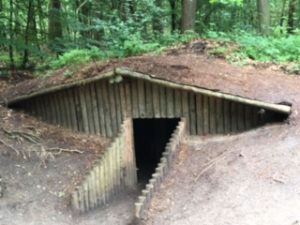
One of about 12 dugout shelters that provided dank living quarters for those fleeing the Germans. This one has been restored. As many as 18 people would crowd into the 16′ x 16′ room.
From 1942 until 1944, the Hidden Village served as a stop on the Dutch Resistance’s underground village, a respite for Jews, downed Allied fliers, and others sought by the Germans. Meanwhile, German garrisons occupied Vierhouten and other nearby towns. The Hidden Village consisted of 12 earthen dugout shelters, similar to prairie sod houses, scattered over a couple acres of deep forest about 4 km from Vierhouten. It housed up to 100 people at a time, and some Jewish residents lived there for months. Townspeople snuck food out to the encampment, and residents were not allowed to venture outside or cook during the day for fear they would be found by the Germans.
The village ended in 1944 due to pure happenstance. Two young boys from the Hidden Village decided to go to a spring for water during the day, against instructions. Meanwhile, two young German soldiers were out hunting for game. The boys were intercepted by the Germans, who quizzed them closely.
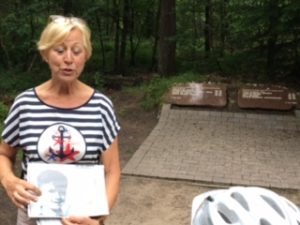
The memorial at the site where the 6 captured villagers were executed by the Germans. Our guide, a volunteer from a nearby village, shows a picture of a victim.
The boys, young Jews from Germany, spoke perfect German and maintained they were on holiday. Feigning interest in hunting, they asked one of the young soldiers to fire his gun. This, in fact, was an agreed-on signal to the village that they had been discovered. The young Germans returned to their garrison to report the incident, and by the time a search party discovered the village, the occupants had fled save for 6 who had decided to return for some treasured goods. The 6 were captured and later executed; all of the others successfully escaped.
The story brings into focus the Dutch’s role during WW II. The Germans invaded and overpowered the Netherlands easily in early 1940, and saw in the Dutch a people who looked, talked and acted much like them. They foresaw a vassal-state that could help staff their war effort with workers, factories, and logistics. The Dutch approach varied, but contained the usual dose of Dutch pragmatism. Some complied—a few enthusiastically, most grudgingly; many more resisted simply by refusing to follow German directions, much to the occupiers’ frustration; and many actively resisted by participating in the Dutch Resistance, which operated throughout the country.
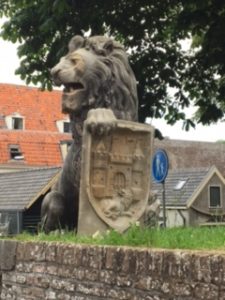
A statue in the town of Elburg, erected after the war by a prominent Jewish resident, honoring the townspeople for their efforts to shelter Jews.
Dutch acceptance and tolerance was a trademark of Amsterdam since the Dutch Golden Age in the 17th century, and intellectuals persecuted in other European cities often sought refuge there. Russell Shorto, in his very readable book, “Amsterdam, A History of the World’s Most Liberal City”, observes that Dutch tolerance was less rooted in deep allegiance to personal rights than it was to “gedogen”, a Dutch word that he suggests means “looking the other way”, or “live and let live.” Its roots were Dutch pragmatism as much as Dutch principle, and there were many instances over the last 300 years when Dutch tolerance did not live up to its reputation. World War II was one of the most troubling times, filled with stories of surrender and complicity as well as stories of defiance and heroism. Amsterdammers both hid German targets, such as Anne Frank’s family, and gave them up to the Germans to be sent to “work camps”, which became death camps. In the countryside, the Dutch Resistance in small towns such as Vierhouten shielded many of their local citizens and shuttled fugitives to safer environs.
The Hidden Village is a story of heroism, and a few survivors still live in Amsterdam and return for an annual commemoration at the site.
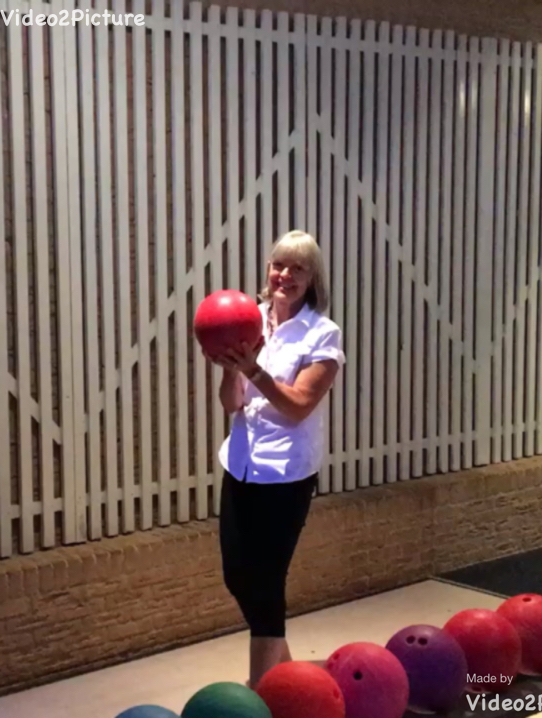

Birthdays on the road surprise by nature—since a fixed site with invitations aren’t in the picture, one must stay open to the possibilities. The calendar showed Betsy’s birthday in the middle of our bike tour and she chose to keep silent about it. Alas, Joppe had our birthdates from our application forms and, per Road Scholar habits, presented Betsy with a sparkling candle on her dessert as we sang the birthday song. Her secret was out.
A day earlier, we had spied a “Bowling” sign with an arrow near the Vigilante Hotel’s dining room. Following the arrow, sure enough, we found a bar featuring a pool table and 4 bowling lanes. Now, the bowling lanes offered a perfect way to celebrate a birthday.
It was largely do-it-yourself bowling, so we rented 2 lanes for an hour, invited the rest of the group to join us, and began knocking down pins. No matter that most of us hadn’t bowled for years! The pins were safe from any real damage as many balls took the easy route and dove for the gutter. Plus the lanes featured an unusual pinsetter—a fine wire connected the top of each pin to its mooring on the pinsetter, so that when pinsetter raised for a re-set, the pins would dance like marionettes before being gently set back down into position. The wire tether kept the pins from exploding into each other—or maybe that was the low rolling velocity on our bowling balls—so there was a dearth of strikes and spares. In fact, with 8 bowlers, no one got to triple digits in score.
That had no impact on the amount of fun, and 76-year-old Hank, our SAG master for the bike tour, delighted for days afterward in reminding us that he scored the highest on his lane.
For Betsy, the impromptu party was a birthday bash, and one she will remember.


Our final day featured a ride through the forest to the summer estate, Het Loo, of the Dutch Royal family. It was developed in the late 1600’s by William III and Mary II as a hunting lodge and is a fairly modest building from the outside as castles go.
It reminded one of our fellow riders of a big-city high school building. The acres of formal gardens to the south bely the initial impression, and the inside is dark and stuffed with royal portraits, heavy furniture, exotic collectibles and other trappings of power.
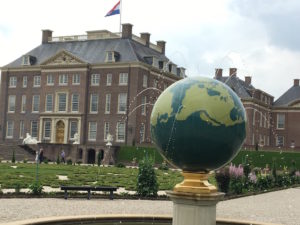
The globe spouts water from each of Holland’s many trading ports throughout the world, a reminder of Dutch Golden Age reach.
Reactions to grand castles vary widely among people, from amazement to romance to historical curiosity to boredom, but for me the visit was disquieting. As an American egalitarian, I cringe at the born-into-privilege political structure it represents. As an architect in love with light and space, the endless trail of dark, over-decorated, heavy-walled rooms dim my spirit. As a naturalist, the acres of carefully circumscribed and manicured gardens look fussy, rococo, and unhealthy.
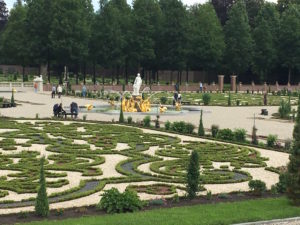
Formal gardens modeled after Versailles–with a noted improvement. The fountains all operate from spring-fed, gravity-powered pipe sources, unlike Versailles fountains which required human-powered pumps.

Halls of power. Again, artificial light is added for photo as interiors are naturally lit only by candelabras.
One can also clearly feel the constraints of power in a tour of Het Loo. The night before our visit we had a wonderful lecture from a Dutch academic, Kees Grandia, that covered, among other things, the Royal Family. He empathized with 13 year old Amalia, current princess and heir-apparent to the throne, who would not have the freedom to pursue her individuality and passions like most young Dutch girls. Her rearing and education is focused on preparing her for her duties as figurehead for the Dutch people.
Het Loo is designed to remind people of the monarchy’s power; at the same time, its weight and formality reminds the royalty of the burdens of their position in modern culture. It can be seen and felt as an opulent triumph or a crypt of power.
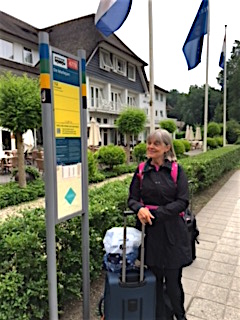

We said goodbye to our Road Scholar group on Sunday night, and on Monday morning we caught a local bus that would take us to a train in Nunspeet, which would take us to another train in Amersfoort, which would deliver us to the Central Station in Amsterdam. The trip was smooth and efficient, and we were afoot in the rain in Amsterdam within 1-1/2 hours. We walked 30 minutes to our AirBnB’s check-in office, took a cab to our Bickersgracht apartments and were greeted by Katie & Kyle, Russell & Monica, all ready to begin the Amsterdam adventure.
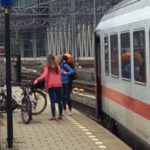
There is a special car on the train for bikes–and we were told you have to pay a full fare for your bike to take it along.

The trains were fast, with minimum transfer time. Two carloads of school children rode the train, apparently on a school trip to Amsterdam. We never saw a school bus in the Netherlands–bike and bus are the way school kids travel.


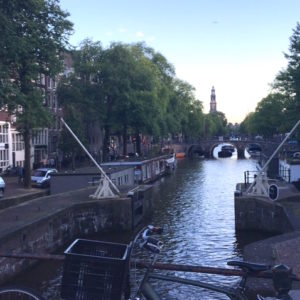
Canal views are everywhere, this one at dusk (which is currently 9:30 PM at this northern latitude).
Amsterdam is wondrous. It is a hub of 21st century human activity taking place in buildings old and new. As the densest city in the EU, it feels remarkably spacious because of the generous amounts of public space—largely canals—and preponderance of 4 and 5 story buildings. The interplay of buildings and canals create magical vistas every couple blocks. It is often referred to as the “Venice of the North”, but unlike Venice, tourism is not its life blood, and in fact Amsterdammers are studying ways to reduce tourists’ impact on their daily lives, which may include ways to discourage tourists.
The only city as inextricably linked with water that I know, other than Venice, is Vancouver. Vancouver may be the most beautiful city in the world, but Amsterdam is a more complete city—it has beauty, brains, dynamism, history and character.
For all the density and bustle, Amsterdam streets feel comfy, not crowded, and the predominance of bicycles rather than cars brings a calmness, a quietude unknown to other large modern cities. The
Dutch disposition may play a role in this as well. Loud conversations, shouting, and horn honking appear to be discouraged in favor of minimal gestures and a few mild words. Drunken group singing on Friday and Saturday nights is the one exception we noted to the general quietude.
There is a multitude of sights to visit in Amsterdam, including museums, boat tours, and architectural monuments. The thing we enjoy most, though, is just being in the street, experiencing the people and life of the city.
The sea defines the Dutch. The earliest occupants of “The Lowlands” were seafarers who owed their survival to the sea. Later, they would band together to build dikes to move back the sea edge and establish more land to farm. Later still, they would use their business acumen and individual initiative to master shipbuilding and international sea trade. And through this all, they would organize collectively to battle the North Sea’s relentless battering of their fragile dike system.
It is a fundamental fact that 50% of the Netherlands is below sea level or at sea level and subject to high tide flooding. Prime, fertile areas of Holland are as much as 20 m. below sea level. Living safely below sea level requires vigilance, engineering, massive electric pumps and lots of money—$330 per year per Dutch resident ($5.6 billion). Few argue or complain about the expenditure, and the science and impact of global warming is not a debate here.
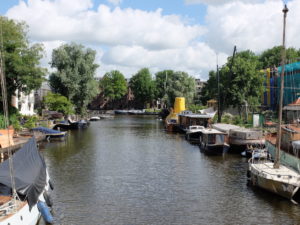
Amsterdam buildings and boats line the canals. Flooding in Amsterdam is not anticipated to be as much of a problem due to the many gates, pumps and and other flood control measures in place.
One benefit of this ages-old battle against the sea is the Dutch now lead the world in hydrological engineering and work world-wide to help other nations solve flood control problems. They also are leaders in responding to at-sea emergencies, salvaging damaged or sunken ships, and building custom ships.
The Dutch will need to keep expanding their expertise in the 21st century as they face rising seas.
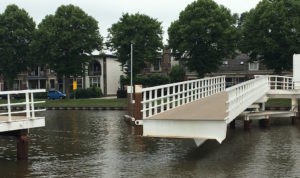
More Dutch engineering: almost all bridges are draw bridges to permit boat and barge navigation. Some are hinged and swing open like a gate as shown here.
Dikes will need to be bolstered and raised, of course; an even more widespread threat will come from the Rhine, Waal, IJ and other major rivers flowing through the Netherlands. As the sea rises, they will rise as well. Couple that with more intense rains in the Alps, and the Dutch will need to build new levees along the length of most rivers to keep flooding at bay.
The $330 per year per resident is likely to go up significantly, the price of staying alive. The Dutch have always been up to the challenge.
Amsterdam features a special segment of Dutch engineering. To build a city in a swamp, the Dutch had to figure out a way to keep buildings upright.
Initially, they built one and two story wood buildings on cowhides. The cowhides spread the light loads enough to keep the houses mostly afloat—an improvised raft. This was not a long-lasting solution, both because of the limited life of wet cowhide and potential fire damage to the wood building above. After much of Amsterdam was destroyed by fire in 1452, the ruling power declared that all new structures had to be built of brick. This required new means to support the additional weight: wood piles.
Until recently, most Amsterdam buildings have been built on wooden piles. Amsterdam’s water table hovers about 1 m. below the surface, rising or falling with rain and drought. The nearest layer of bearing soil is a stria of sand 12 m. below. To reach this, Amsterdammers drove wood poles—generally pine or spruce—through peat and marl. The Centraal Train Station, for example, was built in the late 1800’s using over 8,000 wood piles. As long as the piles stay wet continuously, they do not rot. If the tops of piles extends above the water table and are subject to wet/dry cycles, however, they will eventually rot, causing a difficult structural problem.
Modern building methods use steel or concrete piles and extend down to a second, more substantial, sand layer about 25 m. below the surface. This supports the taller steel and glass buildings one sees along the IJ.
A related engineering problem has been tunnel-boring for underground portions of Amsterdam’s train system. A major north-south expansion of the train system, begun in 2002, requires a 7 km tunnel under the Central Station and the IJ. The challenges of keeping out the water, supporting train weight and avoiding the pin cushion of pilings from existing buildings is immense. In fact, the tunnel–designed by a German company–ran into problems in 2008 and is still not open, though the first train should run in 2017. Here’s what happened:
On 19 June 2008, during the construction of the underground station on the Vijzelgracht, a leak in the concrete wall caused water and sand to flow into the pit. This caused tremors in the wooden piles under the houses nearby, making some houses sink 15 cm into the ground. Residents had to be evacuated. The work was stopped immediately and repairs made. Then, on 9 September 2008, construction started again. The next day, more houses sank, this time 20 cm within the hour. Cracks started to appear in the walls and windows, and doors wouldn’t budge. The row of 300-year-old houses, known as the Weavers Houses, became suddenly uninhabitable.
This is why Dutch architects and engineers lie awake in the middle of the night!
Where are the traffic jams in Amsterdam? Amsterdam is the densest city in the European union, the financial capital of the Netherlands and part of an extended metropolis of 7 million people. Amsterdam proper has about 800,000 inhabitants—and 1.2 million bikes. There’s a good reason many people have more than one bike—the kid transport you use to take your two toddlers to daycare or haul groceries from the store may be a tough pedal to your corporate job in Centraal.
Amsterdammers do not ride expensive bikes. They ride heavy, durable work horse types, black, single-geared, with coaster brakes or hand brakes. Since 80,000 bikes are stolen each year, there’s little pride of possession and most residents use 2 locks to secure a bike. They also ride in the rain, cold, and wind, given Amsterdam’s English-style climate, and plain black bikes can be dirty or rusty without anyone caring too much.
It’s amazing how tiny a bike footprint is compared to a car’s. A bike with one or two occupants may cover 10 SF, whereas a compact car with 1 occupant will cover 50 SF. A bike leaves lots of room for others. Plus bikes are more nimble at intersections—the locus of most congestion—, meaning they can stack more densely and disperse more quickly.
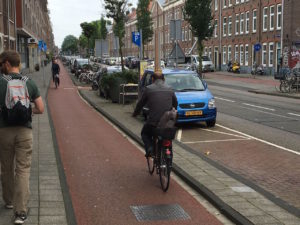
On main streets, pedestrian, bike and car paths are clearly defined. On minor streets, everyone shares, although bikes generally have the right of way.
This isn’t to suggest that car-driving in Amsterdam isn’t a frustrating experience. It must be, given the many road and right-of-way restrictions. It is just to say that a city that gives equal weight to pedestrians, cyclists, trams and cars, and is dense enough to keep trip distances short, does not experience congestion like cities that prioritize only cars. As a native Amsterdammer, Eva, said, “Why would I have a car when the streets are narrow and it’s hard to find a parking space and I can get everywhere on my bike?”
Remarkably, in our brief time in Amsterdam, we have seen no collisions or crashes. Bikes, walkers, trams, work vehicles and cars create a melee’ of activity on Amsterdam’s narrow streets and free-lancing the rules, especially by cyclists, is fairly common. Yet there appear to be few “incidents.” It took us four days to see a middle finger issued in response to road behavior—by a motor-vehicle driver, of course. This may be partly a tribute to Dutch tolerance and collectivism, but it seems to be mostly due to controlled speeds, alert action and agreement on the advantages of road-sharing.
Amsterdam has one more distinct advantage over a city like Atlanta: terrain. Amsterdam is generally listed as 1 m. below sea level, with the highest point in the city being about 17 m. above sea level, but in fact most of the city shows elevation differentials of no more than 4 m. That is FLAT! And it means anyone can ride a bike, and bike gearing is unnecessary for most situations.
Riding a bike around Amsterdam can be daunting at first as one learns the basic road rules. Then it becomes exhilarating. You can get anywhere quickly without delays.
The basic road rules, as outsiders say, is “there are no rules”. This is not true. There are many clear rules regarding right-of-way and traffic signals, and bikes have protected bike lanes and directional privileges everywhere. One of the basic rules is that you may break any rule on a bike as long as you don’t collide with someone else. If you give the car/cyclist/motorbike time to avoid a collision, you’re OK. If not, stop. Whoever’s behind you better stop also. Instantly. Anticipate everything that might happen in front of you so you can stop on a dime, or swerve onto a sidewalk, or speed through a gap.
The roads that line the concentric canals are fun. They’re paved with brick, one-way for cars but two-way for bikes, and they go up and down at the bridges. Service vehicles can be parked in the middle of them, leaving a 1 m. gap to cruise through to the left or right. Pedestrians wander down the middle of the roads. Faster bikes pass on the left and the right. Scenic canals line the way if you have time to look.
Amsterdam biking is akin to mountain biking. It requires the same skills. Instead of dodging rocks and tree roots, you dodge road hazards and bikes and walkers. You are locked in. You need quick power to get through a gap, then a combo braking/turning maneuver to avoid a pavement gap, a bunny hop to get up a curb, cold guts to face down a car reluctant to give way. Time speeds along, the scenery is amazing and you arrive at your destination before you ever thought you could. You even ride with low tire pressure for traction and cushioning. No one wears helmets, though, except American tour groups constrained by liability insurance.
We rented bikes after the first couple days for the duration of our stay, and even the novice bike riders among us enjoyed the freedom and challenge of two wheels. It’s the quintessential Amsterdammer way to experience the city, although our bike helmets and timidity assured we wouldn’t be mistaken for natives.
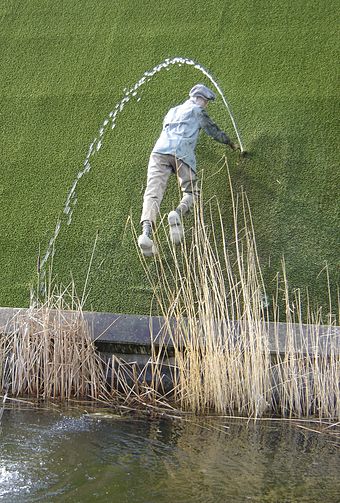

Hans Brinker is not Dutch. We were informed of this by our Dutch guide shortly after arriving in the Netherlands. Huh? “Hans Brinker, or The Silver Skates” has been celebrated literature since the mid-1800’s in American schools—most famously as propagator of the story of the little Dutch boy who stuck his finger in a dike to save his country. This little story-within-a-story, called “The Hero of Haarlem”, is told in the book as part of the larger Hans Brinker narrative, although the hero, unnamed, is NOT Hans Brinker.
Can this have never happened???
It turns out that “Hans Brinker” was written by an American, Mary Mapes Dodge, who had never visited the Netherlands. She leaned on book research and Dutch neighbors to fill in authentic details about Dutch life and history. In the end, she produced an inspiring tale about an honorable lad who does the right thing despite difficult family circumstances. It is also, intrinsically, an American fable.
Russell Shorto, American author of the excellent book “Amsterdam: A History of the World’s Most Liberal City” explains in a discussion of Dutch character. The story of the boy and the dike perplexes the Dutch because, first, a small hole in a dike through which water pours is an impossibility, and, second, the Dutch would never bring up a child to think he/she should stop this crisis on his/her own. In a Dutch version, the child would run to the local Water Board, which would pull out an emergency plan and marshall local citizens to fix the dike. The history of the Dutch struggle against the sea is all about group effort.
“Hans Brinker”, then, illustrates the difference between American individualism and Dutch collectivism. This, of course, has not kept a few Dutch towns from trying to capitalize on tourism by erecting a statue to the hero of the story or an Amsterdam hostel from naming itself “Hans Brinker Budget Hotel”. But according to Wikipedia’s entry on the subject, seconded by our guide, Joppe, “The story of the dike-plugging boy is….not widely known in the Netherlands — it is a piece of American, rather than Dutch, folklore.”
We always come back with a collection of noteworthy moments and photos that haven’t found their way into a post. Here’s the Dutch scrapbook.
This is how Dutch school kids get to the annual all-district field day:
And this is how the Dutch “Share the Road.” This is a common road design in rural areas. Note the e-bikes, which are increasingly common there (especially for tourists).